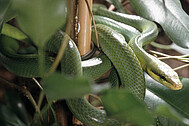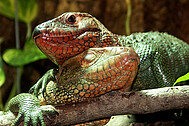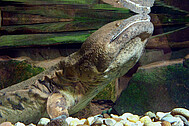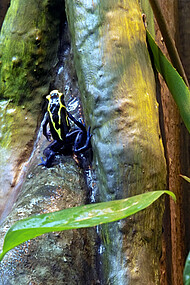Our terrariums
Let yourself be captivated by the reptiles and amphibians in our Vivarium. As you step into the museum, you will be greeted by the sight of the largest living member of the salamander family, the Chinese giant salamander (Andrias davidianus), which is also featured on the museum's crest and serves as its "mascot".
Four paludariums – vivariums in which there is not only a terratic area but an aquarium with fish from the same biotope – recreate the impression of a riverbank in the jungle. Terrarium inhabitants such as the Northern Caiman lizard (Dracaena guianensis), Indonesian forest dragon (Hypsilurus dilophus) and the blue spotted tree monitor (Varanus macraei) feel right at home here, and all of their many interesting behaviours can be seen.
In the large Australia vivarium, you will find creatures which prefer a drier environment, such as the black-headed python (Aspidites melanocephalus), the central bearded dragon (Pogona viticeps) and frill-necked lizards (Chlamydosaurus kingii).
Take a moment to observe the panther chameleon (5) (Furcifer pardalis) more closely. With its changing colours, its eyes that move independently and the long tongue it uses to catch its prey, there is quite a bit to see.
If you take a closer look at this terrarium, you will find the false tomato frog (Dyscophus guineti) has burrowed into the ground. This animal clearly earned its name because of its bright red colour. Other members of the order Anura in our vivarium include the Australian green tree frog (Litoria caerula) and giant tree frog (Litoria infrafrenata), the giant leaf frog (Phyllomedusa bicolor), the Argentine horned frog (Ceratophrys ornata) along with poison dart frogs (Ameerega trivittata, Phyllobates terribilis.) and the spotted toad (Bufo guttatus).
The tree python (Morelia viridis) and eyelash viper (Bothriechis schlegeli) are only active at night; they spend their days coiled up asleep in branches.
The Karlsruhe Vivarium has had repeated successes in breeding animals. The greatest highlights of the past several years include the black-headed python (Aspidites melanocephalus), which is rarely kept in captivity, and the tomato frog (Dyscophus guineti), which we were effectively able to help reproduce without the use of hormones.










